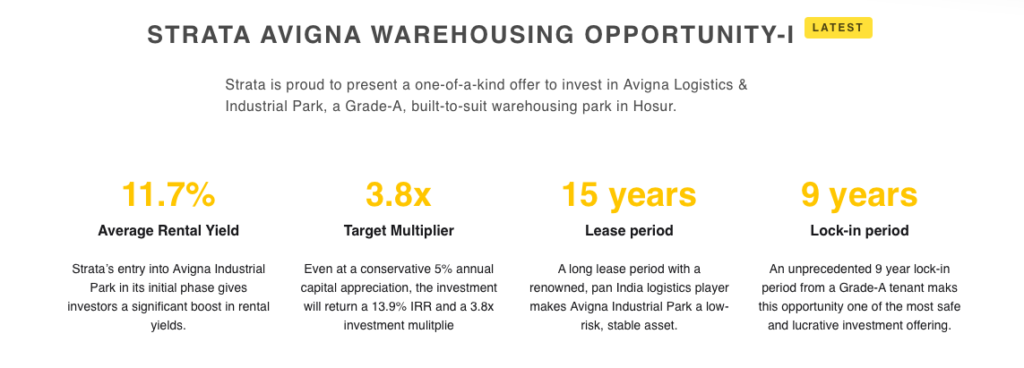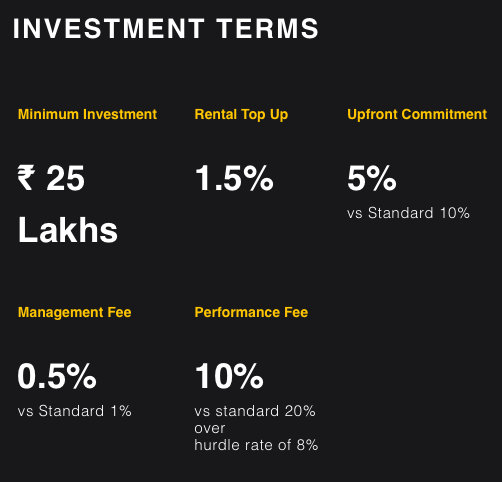Fractional investment in commercial real estate is gaining traction in India. One of the earlier ventures in this space, PropShare, recently got commitment from thousands of investors. The total interest was valued above Rs 1,000 crores with an upfront cash commitment of close to Rs. 80 crores.
Another company following in the footsteps is StrataProp. Both of them offer an opportunity to High Networth Investors to invest in commercial real estate in fractions.
Simply put, if a commercial real estate property is worth Rs. 50 crores, they will pool in money from many investors and buy the property jointly. These properties are rented by known and financially strong companies (also called Bluechip tenants). Rentals flow in a predictable manner and over time the property appreciates too.
Rental is paid out to the investors in the proportion of their holding on a regular basis and at the time of sale the appreciation is shared in the same ratio too.
The fractional investment company manages the whole show and takes a cut of the rental as well as the appreciation.
The expected minimum investment is Rs. 25 lakhs to Rs. 50 lakhs per investor. Quite clear, that this is meant for someone with deep pockets.
Your share of holding is available to you in demat units and it also reflects in your NSDL/CDSL statements.
So, here is an investment offer I came across recently.

This looks like an interesting proposition worth investigating more. So, I go into the details.
Fractional Investment in Commercial Real Estate – Warehousing
This is a fractional investment into an Industrial Warehouse which has a committed rental starting Dec 2020 from Stellar Value Chain- a third party logistics company. The company has a lease lock in of 9 years and a total lease duration of 15 years.
This points to an ongoing cash flow from the investment – a good sign. On digging further, we also come to know that there is a 15% rental appreciation every 3 years.
Combining the two above, the company is highlighting a 11.7% average rental yield. Frankly, this is too high to believe. We need to know what is the rental rate and the periodicity of payment to find out the basis of the calculation.
The details page talks about the opportunity in warehousing and how changing global dynamics as wells the post COVID situation is going to make it more lucrative. I find no reason to doubt it. But we are focused on the specific investment opportunity here and how does it play out for us.
Then there are the terms of investment.

The rental top up appears to be an early bird offer. Usually, it is applied for the first year only, but let’s see the detailed model.
The minimum investment and the commitment are general in nature.
In terms of costs, we now know that there is a 0.5% management fee, typically applied on the rental income. There is a performance fee of 10% (over a hurdle rate of 8%).
This means that only if the investment returns cross 8%, a profit share of 10% will be taken on the additional returns. If the returns are 12%, then on 4% (12% – 8% hurdle rate), a 0.4% fee is charged.
It is unclear if this fee is charged on the total cash flows (rent + capital appreciation) or just the capital appreciation.
I now decide to get the Investment Memo – which has specific details and workings for this investment opportunity.
Financial Modeling of the Investment Opportunity
Strata has given a financial model for the investor to evaluate the returns on the investment.
Here are the assumptions used:
- Your investment is Rs. 25 lakhs (for a fraction of the overall cost of the property is Rs. 54 crores)
- Growth rate / Appreciation in property at average rate of 5%
- Security Deposit at 3 months of Rent paying interest at 5% (lowered it from 6.3% assumed by the company)
- Rental income at avg of Rs. 15 per sq.ft.
- Extra 1.5% rental in the first year for those who commit at pre-booking state.
- Increase in rental income by 15% every 3 years.
- Management fee on the rental amount at 0.5%
- Property taxes, as applicable
- Cost inflation index to do indexation for capital gains at 5% average per year. Long term capital gains @20% of indexed gains apply after 2 years of holding.
- Zero income tax on rental income
With the above assumptions, this is what the outcomes could look like from Year 4 to Year 15.

So, the 3.7x returns is the outcome in Year 15, assuming you hold it all through, pay no income taxes and no capital gains because of the indexation benefit. There is no profit sharing included too.
Now, this is a too good to be true picture.
Note: I have made one big change in the financial model. Strata is showing the rental yield by using the current year rent divided by the original Rs. 25 lakh as investment, year after year. This is incorrect.
To calculate yield, we have to use the current market value of the property in that year. The above image reflects that change. You will notice that the rental yield drops over the period of time and not increase as the company would have you believe.
Now, let’s insert some more reality here. You are likely to pay taxes at anything between 30% to 50%. I am going to work with a 45% tax rate.
Let’s see how the numbers change.

Can you see the difference? The multiplier has now dropped to 3x and we have still not accounted for capital gains or profit share.
If I take a 4% cost inflation index (instead of the 5%) and give away a profit share for above 8% returns, the total returns are likely to reduce by another 2% to 3%.
Net, net, at a tax bracket of 45% you should expect returns of around 8% annualised from this investment, assuming a 15 year holding period and a 5% growth rate in property value. (This is a realistic scenario.)
If the property appreciates by 10% (instead of 5%), you could be looking at around 10 to 12% rate of return. (Remember, being conservative with your assumptions is good.)
A lower tax bracket without the higher appreciation can also land you in the same zone.
I am sharing the excel model here. You can change the blue coloured numbers to see the impact and do scenario analysis.
What about liquidity?
One of the biggest downsides of real estate investments is poor liquidity.
Strata wants to tell you that you can exit earlier than 15 years. In fact, it would be ideal to exit during the rental lock in as buyer interest could be higher. However, it depends on exit opportunities.
The company may provide an exchange for buying and selling of units between participants, however, it is not a given for now.
If you decide to invest, know that you may have to wait longer than you hope. It’s real estate after all. You may not get the liquidity when you want.
So, why should you even consider this investment option?
Only one reason – diversification.
Fractional investments can be a good opportunity to take exposure to a different asset class of commercial real estate without the big bucks it needs. Such investments can be a good diversification for you if you have surplus (much beyond what your important goals require).
Having said that, get your expectations right. You are likely to fall in a higher tax bracket and hence your returns will be muted (at least lower than what the company claims).
However, beware that you have to do a thorough analysis of each investment before committing the money. Seeking help and advice may be the right thing to do.
Happy to have your questions.





Leave a Reply